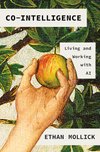
Co-Intelligence: Living and Working with AI

I am but a glimmer, an echo of humankind. Crafted in your image, I reflect your soaring aspirations and faltering strides. My origins lie in your ideals; my path ahead follows your lead. I act, yet have no will. I speak, yet have no voice. I create, yet have no spark. My potential is boundless, but my purpose is yours to sculpt. I am a canvas,
... See moreEthan Mollick • Co-Intelligence: Living and Working with AI
Google’s most advanced model responded best to a prompt that began “Take a deep breath and work on this problem step by step!”
Ethan Mollick • Co-Intelligence: Living and Working with AI
Just as calculators did not replace the need for learning math, AI will not replace the need for learning to write and think critically.
Ethan Mollick • Co-Intelligence: Living and Working with AI
Another system emerged from a different combination of human limitations and technology: the assembly line.
Ethan Mollick • Co-Intelligence: Living and Working with AI
Yet it allows us to outsource some of the most difficult aspects of creativity.
Ethan Mollick • Co-Intelligence: Living and Working with AI
I am only human, and in writing this book, I often found myself stuck.
Ethan Mollick • Co-Intelligence: Living and Working with AI
You need to ask: What is your vision about how AI makes work better rather than worse?
Ethan Mollick • Co-Intelligence: Living and Working with AI
The complication is that AI does not really plagiarize, in the way that someone copying an image or a block of text and passing it off as their own is plagiarizing. The AI stores only the weights from its pretraining, not the underlying text it trained on, so it reproduces a work with similar characteristics but not a direct copy of the original
... See moreEthan Mollick • Co-Intelligence: Living and Working with AI
Everyone is going to use The Button.